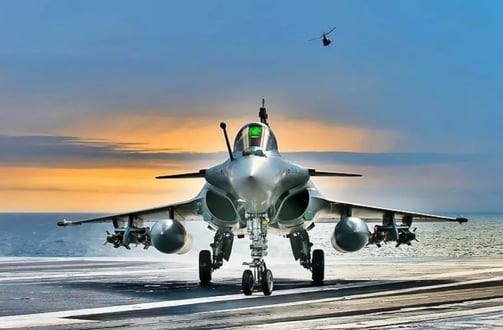

In a landmark move that will reshape India's naval aviation and reinforce its maritime posture, the Cabinet Committee on Security (CCS), chaired by Prime Minister Narendra Modi, has approved the acquisition of 26 Rafale Marine (Rafale-M) fighter jets for the Indian Navy. This decision, coming after prolonged evaluations and trials, reflects India's growing emphasis on sea-based deterrence in the Indo-Pacific region and addresses the urgent need to replace the aging MiG-29K fleet.
The procurement, valued at approximately EUR 5.5 billion, includes 22 single-seat and 4 twin-seat Rafale-M jets. These aircraft will be deployed aboard India’s two aircraft carriers—INS Vikramaditya and the indigenously built INS Vikrant—ushering in a new era of naval air power.
Rafale Marine: A Carrier-Capable Multirole Beast
Technical Specifications and Combat Features
The Rafale-M is the naval variant of the Dassault Rafale, manufactured by Dassault Aviation of France. Specifically designed for aircraft carrier operations, it incorporates reinforced landing gear, tailhook for arrested landings, and an upgraded nose wheel for catapult launches.
> Key Specifications:
Length: 15.3 meters
Wingspan: 10.9 meters
Maximum Speed: Mach 1.8 (2,222 km/h)
Combat Range: 1,850 km (without mid-air refueling)
Service Ceiling: 50,000 feet
> Armament:
Meteor Beyond Visual Range (BVR) missiles
MICA air-to-air missiles
SCALP-EG cruise missiles (precision strikes)
AM39 Exocet anti-ship missiles
Hammer guided bombs
30mm GIAT 30 internal cannon
> Avionics:
RBE2-AA AESA radar
SPECTRA electronic warfare suite
Front-sector optronics and helmet-mounted sights
Superior Combat Worthiness
The Rafale-M is designed as an "Omnirole" fighter. It can switch from air-to-air to ground-attack missions mid-flight. Its combat worthiness lies in its agility, advanced sensors, and multi-role capability—making it a reliable platform in contested environments.
Survivability: Its low radar cross-section and superior electronic warfare (EW) systems allow it to operate in dense air defence environments. In Indian Ocean scenarios, this gives it the edge over Chinese J-15 and J-35 jets.
Combat Proven: From Libya to the Middle East
Unlike many newer platforms still in the testing phase, the Rafale (including its naval variant) is battle-proven.
Combat Engagements
Libya (2011): Rafales participated in NATO’s Operation Unified Protector, executing airstrikes and surveillance missions.
Mali (2013): Rafales executed precision strikes during France’s Operation Serval against insurgents.
Syria and Iraq (2014-2019): Rafales were extensively used against ISIS targets with high accuracy.
The Rafale-M also operated from France's aircraft carrier Charles de Gaulle, flying hundreds of sorties, showcasing its ability to conduct sustained naval operations.
Non-Combat Missions
Maritime surveillance
Intelligence, Surveillance, and Reconnaissance (ISR)
Nuclear deterrent patrols (France deploys nuclear-capable Rafales)
Its performance in humanitarian assistance, disaster response (HADR), and maritime search and rescue (SAR) also adds to its multi-utility in peacetime operations.
Global Operators and Strategic Partnerships
Apart from France, the Rafale has been inducted by several key strategic players:
India (IAF): 36 Rafale fighters are already in service, significantly enhancing air dominance.
Egypt: Operates 54 Rafales.
Qatar: Fields 36 Rafales.
Greece: Acquired 24 Rafales.
Indonesia: Recently signed for 42 Rafales.
With the Rafale-M deal, India will become the only country (besides France) to operate both Air Force and Naval variants, strengthening interoperability and logistics.
Why Rafale-M and Not F/A-18 Super Hornet?
The Indian Navy conducted extensive trials with both Boeing’s F/A-18 Super Hornet and the Rafale-M at INS Hansa, Goa. Despite the Super Hornet's proven record, the Rafale-M edged ahead due to:
Better suitability with INS Vikrant’s ski-jump deck
Commonality with IAF Rafales (spares, training, logistics)
Superior performance in short take-off and landing (STOBAR) configuration
Strategic Implications in the Indian Ocean Region (IOR)
IOR: A Strategic Crossroads
The Indian Ocean carries over 80% of global oil trade and one-third of the world’s shipping. Control over this region ensures leverage in global geopolitics.
Rafale-M jets will patrol these critical sea lanes and counter increasing threats, including piracy, maritime terrorism, and hostile naval activity.
Deterrence Against Regional Adversaries
China: With its growing naval presence in the IOR (via Gwadar, Hambantota, and the Djibouti base), China aims to encircle India through the so-called "String of Pearls."
Pakistan: Development of new submarines and missile systems heightens the need for India to strengthen its sea-based ISR and strike capability.
The Rafale-M provides a rapid-response, high-performance platform to address these threats and project power.
Countering China in the Indo-Pacific
Indo-Pacific: The New Geopolitical Theatre
The Indo-Pacific has become the epicenter of 21st-century geopolitics. With China's PLA Navy fielding over 355 ships and deploying J-15 carrier jets, India's maritime security faces increasing challenges.
Force Multiplier Effect
Rafale-M vs. J-15: The Chinese J-15 ("Flying Shark") is heavier, lacks advanced EW capability, and faces serious issues in catapult launches and carrier recoveries.
Interoperability with QUAD partners
Rafale-M can enhance coordination with French and US naval forces, especially during joint exercises like Malabar.
Carrier-based deterrence
Unlike land-based aircraft, carrier jets like Rafale-M extend India’s strike range deep into the South China Sea if required.
Boost to Indigenous Defence Ecosystem and Future Roadmap
Though the Rafale-M deal is an import, it paves the way for knowledge transfer, especially in naval aviation.
Enhancing Naval Aviation Training and Doctrine
With advanced simulation systems, maintenance facilities, and real-time experience from Rafale operations, Indian defence academies and naval aviation command will benefit immensely.
Synergy with Indigenous Efforts
The experience with Rafale-M will support:
Development of Twin Engine Deck-Based Fighter (TEDBF) by HAL and DRDO
Upgrades in INS Vikrant’s aviation support systems
Improved pilot training programs at INS Garuda and INS Hansa
Strategic Autonomy and the Indo-French Partnership
This deal highlights the depth of the Indo-French strategic partnership. France is India’s key Indo-Pacific ally, with territories like Reunion and military presence in Djibouti and Abu Dhabi.
Joint patrols, tech sharing, and trilateral cooperation with the UAE have been increasing. Rafale-M enhances this maritime partnership.
A Defining Step for India's Blue-Water Navy
The clearance of the Rafale-M proposal is not just a procurement decision; it represents India’s strategic vision of transforming into a blue-water navy with the capability to dominate its sphere of influence in the Indian Ocean and contribute to global maritime security.
With these jets, India gains a qualitative edge, enhances deterrence against adversaries like China, boosts defence ties with France, and strengthens its resolve to be a net security provider in the Indo-Pacific.
